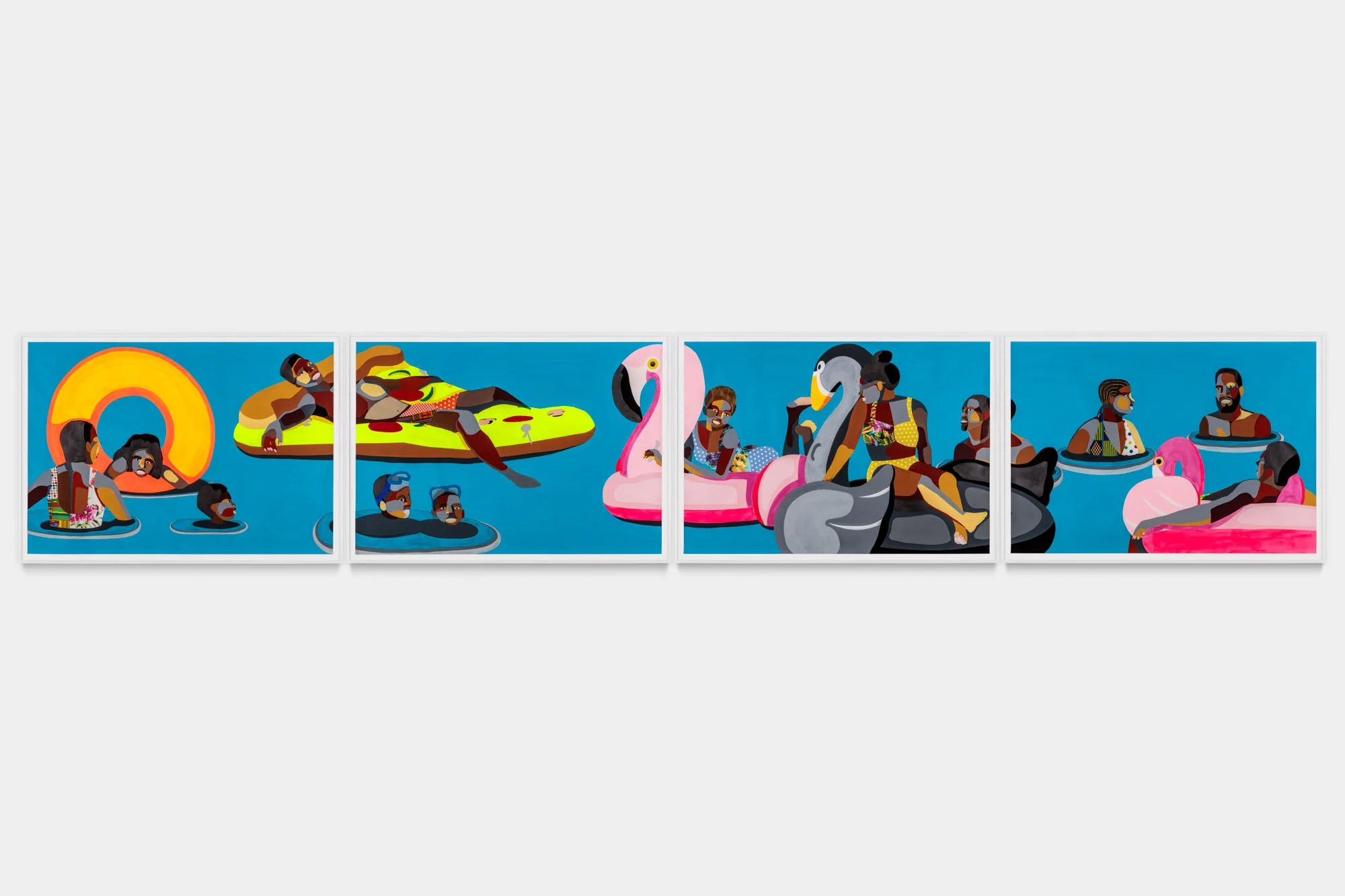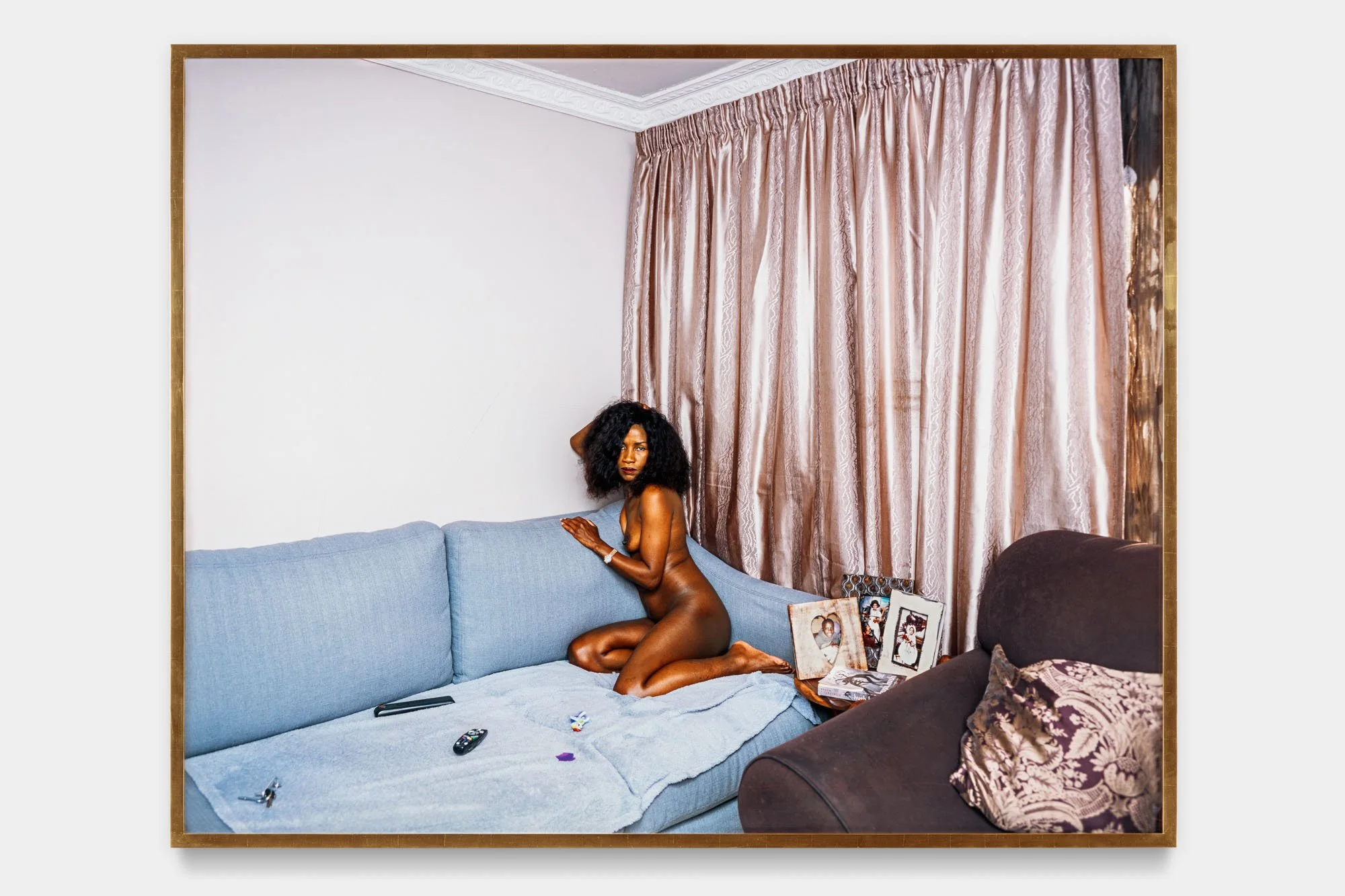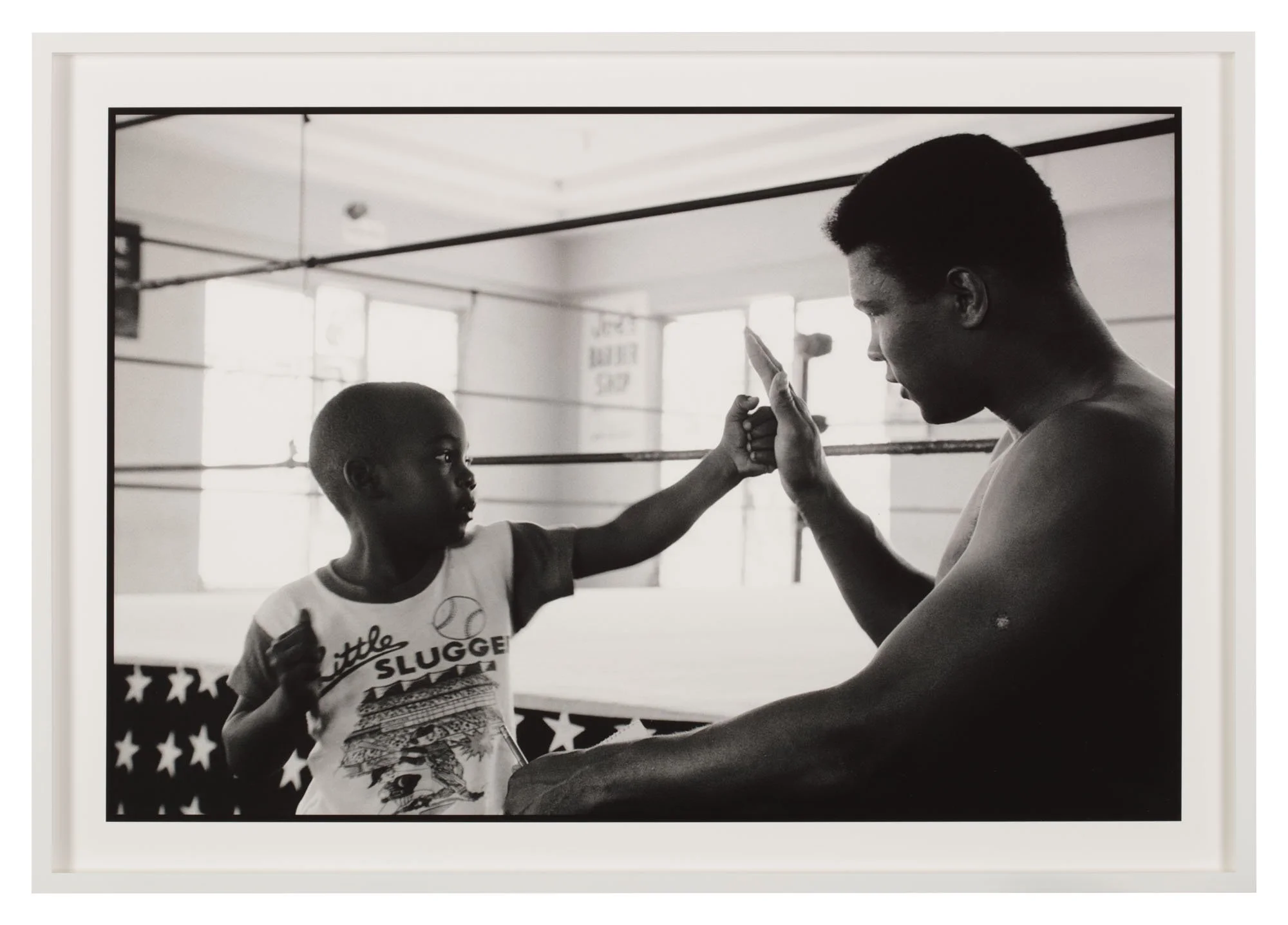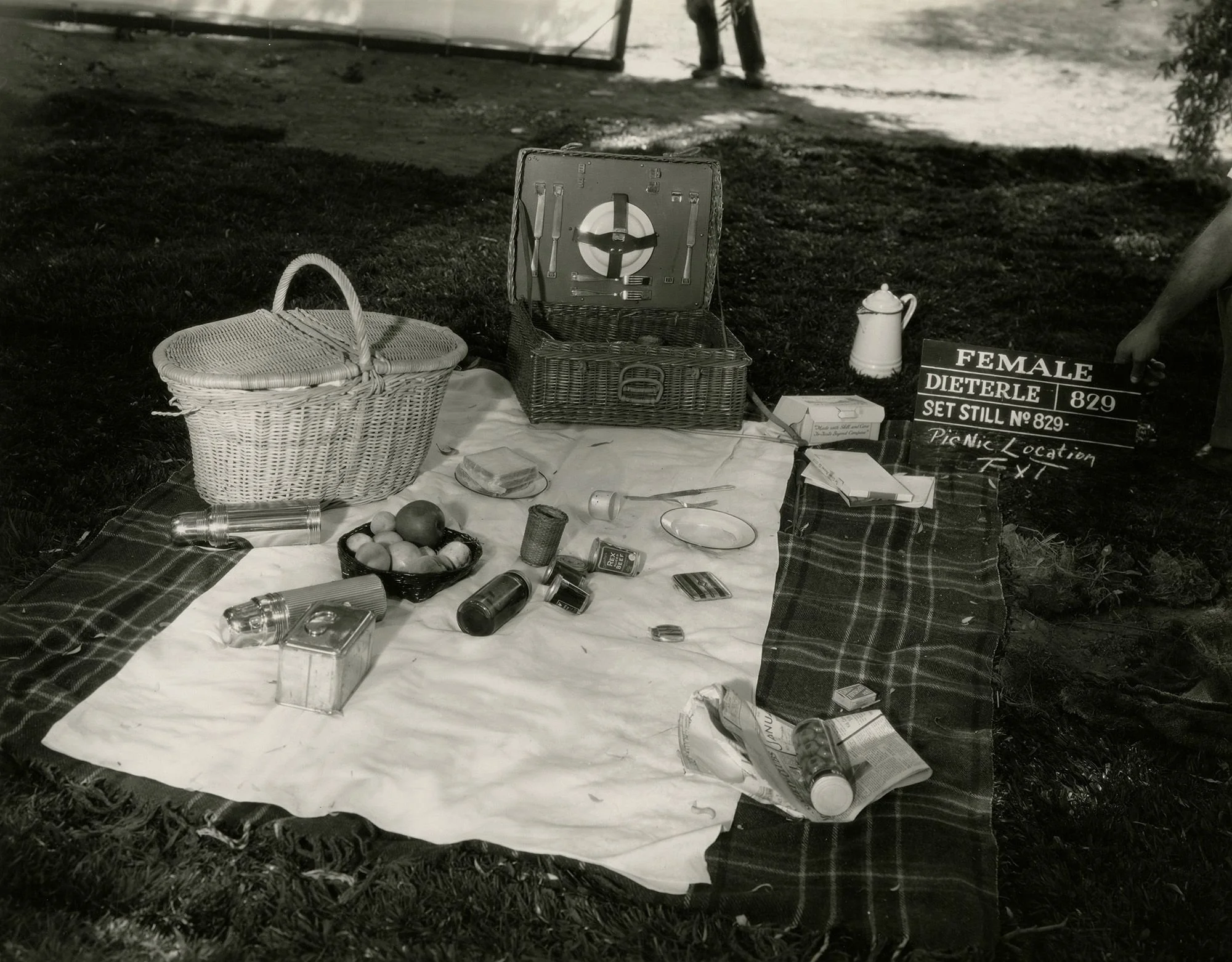Giants: Art from the Dean Collection of Swizz Beatz and Alicia Keys | Brooklyn Museum
Derrick Adams (born Baltimore, Maryland, 1970). Floater 74, 2018. Acrylic paint, pencil, fabric collage on paper, 54 x 304 in. (127 x 182.9 cm). The Dean Collection, courtesy of Swizz Beatz and Alicia Keys. © 2023 Derrick Adams Studio. (Photo: Joshua White / JWPictures.com)
Written by Trip Avis
Photo Edited by Kelly Woodyard
As you enter Giants, the new exhibition at the Brooklyn Museum consisting of vibrant, thought-provoking works from the Dean Collection of musical vanguards, husband and wife Swizz Beatz (Kasseem Dean) and Alicia Keys, you are greeted with the quote: “We need to be our most giant selves: to think our most giant thoughts, express ourselves in the biggest way possible, and give ourselves permission to be giants.” This galvanizing message operates as an encouragement on multiple levels: a proposition to prepare a mind open to inspiration as viewers take in the impressive array of work across mediums and, most importantly, as a rallying cry to Black American, African, and African diasporic artists—both contemporary and historical—to claim their rightful place among the giants of art and culture. On display between February 10th and July 7th, 2024, Giants: Art from the Dean Collection of Swizz Beatz and Alicia Keys will dazzle, celebrate, critique, and inspire—all while promoting “giant conversations.”
Kehinde Wiley (born Los Angeles, California, 1977). Femme piquée par un serpent, 2008. Oil on canvas, 102 x 300 in. (259 x 762 cm). The Dean Collection, courtesy of Swizz Beatz and Alicia Keys. © Kehinde Wiley. (Photo: Glenn Steigelman)
Giants in their own right, the Deans are paying it forward by championing other Black artists through their diverse, expansive collection. Their twenty-year dedication to art collecting has given them the unique and peerless opportunity to support living Black artists: promoting and expanding the cultural reach of photographers such as Jamel Shabbaz and Deana Lawson. Concurrently, they are tasked with honoring and preserving the legacies of crucial photographic figures like Gordon Parks and Kwame Brathwaite.
Amy Sherald (born Columbus, Georgia, 1973). Deliverance, 2022. Oil on linen, each 108 1/4 x 124 1/4 in. (274.8 x 315.5 cm). The Dean Collection, courtesy of Swizz Beatz and Alicia Keys. © Amy Sherald. Courtesy of Amy Sherald and Hauser & Wirth. (Photo: Joesph Hyde)
One of the main goals of the exhibition is to raise conservation between the displayed works: the past and present are invariably in dialogue, highlighting similarities and differences in artistic perspective and personal experience. This dialogue is visible in the spiritual and compositional relationship of two portraits: Gordon Parks’ Eldridge Cleaver and His Wife, Kathleen, Algiers, Algeria (1970) & Jamel Shabbaz’s Kasseem & Alicia (2018). The circumstances surrounding the pairing bridge the past and present, like the pictures themselves: Shabazz was honored in 2018 by the Gordon Parks Foundation Awards, positioning him as an inspired choice to photograph the couple for an article detailing their possession of the most extensive private collection of Gordon Parks photographs.
Deborah Roberts (born Austin, Texas, 1962). The Visionary, 2018. Acrylic paint, ink, found photographs, gouache on paper, 30 x 22 in. (76.2 x 55.9 cm). The Dean Collection, courtesy of Swizz Beatz and Alicia Keys. © Deborah Roberts. (Photo: Glenn Steigelman)
The connections extend beyond the lens to the subjects themselves. From an aesthetic standpoint, the images mirror one another: Keys dons bright red and wears an afro hairstyle, draping her arm over Dean’s shoulder, clad in a black turtleneck, clearly referencing the 1970 portrait. However, the parallels between the couples are more than surface level. Both are recognized for their advocacy. The Cleavers are known historical figures: both were leading members of the Blank Panther Party and influential activists in the Black Power Movement. The Deans continue their legacy through their unyielding support of fellow Black artists across the modern cultural landscape.
Jamel Shabazz (born Brooklyn, New York, 1960). Breezy Boy Breakers, Midtown Manhattan, NYC, 2011. Chromogenic print, 11 x 14 in. (27.9 x 35.6 cm). The Dean Collection, courtesy of Swizz Beatz and Alicia Keys. © Jamel Shabazz. (Photo: Glenn Steigelman)
Jamel Shabazz’s depictions of Black life in the vibrant streets of New York vibrate with heady liveliness and optimism. Images like Breezy Boy Breakers, Midtown, Manhattan, NYC (2011) and Trio, Brooklyn, NYC (1980) are over thirty years removed but buzzing with a colorful immediacy and youthful comradery that transcends time and place. Both images are set in New York’s subway system, an integral facet of city life. The former depicts a group of breakdancers clad in green New York Cosmos tracksuits, a clear sense of pride and enjoyment in their talents captured on camera. This sense of community is equally felt in the 1980 image, which depicts three teenage boys matching in red on a near-empty subway car. Two seated subjects engage in a friendly handshake while their standing companion looks on with arms crossed and a wry smile beneath his red bucket hat. The photographs have a warmth and intimacy that makes you feel like a friendly co-conspirator along for the ride.
Jamel Shabazz (born Brooklyn, New York, 1960). Morning rush Hour, Brooklyn, NYC, 1980. Gelatin silver print, 14 x 11 in. (35.6 x 27.9 cm). The Dean Collection, courtesy of Swizz Beatz and Alicia Keys. © Jamel Shabazz. (Photo: Glenn Steigelman)
Deana Lawson’s travels send her beyond the scope of her native New York State to forge deep personal and artistic connections. Her work captures the nuances of individual experiences while building a global network: “Lawson’s commitment to establishing a rapport with each subject has produced a Black diasporic community that transcends borders.” Her 2017 experiences in the Johannesburg township of Soweto saw Lawson build relationships that birthed colorful, affectionate photographs like Brother and Sister Soweto and Soweto Queen (both 2017).
Deana Lawson (born Rochester, New York, 1979). Soweto Queen, 2017. Pigmented inkjet print, 55 x 69 in. (139.7 x 175.3 cm). The Dean Collection, courtesy of Swizz Beatz and Alicia Keys. © Deana Lawson. (Photo: Joshua White / JWPictures.com)
The first depicts a young man flashing a hand signal while his young sister hides tenderly behind his leg. The intimacy of the setting underpins the connection between the photographer and the subject. Welcomed into their home, Lawson photographs them surrounded by personal items—a shoe collection, a family photograph, and a Justin Bieber-stickered mirror. Soweto Queen captures a nude woman lounging on a sofa beneath closed satin curtains. Her pose is sensual and confident, and her gaze is casually assured. Like the former image, the viewer can feel the trust and connection built between Lawson and the people she photographs—a trust that lends to a striking, honest image.
Kwame Brathwaite (Brooklyn, New York, 1939-2023, New York, New York). Untitled (Model Who Embraced Natural Hairstyles at AJASS Photoshoot), circa 1970, printed 2018. Pigmented inkjet print, 60 x 60 in. (152.4 x 152.4 cm). The Dean Collection, courtesy of Swizz Beatz and Alicia Keys. © Kwame Brathwaite. (Photo: Joshua White / JWPictures.com)
In a segment titled On the Shoulders of Giants, the exhibition celebrates the impactful legacies of photographers who captured, shaped, and influenced history with their camera lenses. One of these giants of the medium was Kwame Brathwaite, a New York native and significant figure in the Black is Beautiful movement. His glamorous shots of models wearing their natural hair with striking ornamentation against rich, colorful backdrops are among the most eye-catching in the exhibition. With his images, Brathwaite bolstered a bold, new vision of glamour for an era mired with racial strife yet brimming with bravery and change. His work promoted a concept of Black beauty and elegance, inspiring awe today. Portraits like Untitled (Radiah Frye Who Embraced Natural Hairstyles at AJASS Photoshoot) [1970] and Untitled (Sikolo Brathwaite with Headpiece Designed by Carolee Prince) [1968] beautifully encapsulate this effort to broaden the social dialogue surrounding beauty, fashion and femininity.
Gordon Parks (born Fort Scott, Kansas, 1912-2006, New York, New York). Untitled, Miami, Florida, 1966, printed 2018. Gelatin silver print, 29 3.16 x 40 3/16 in. (74.1 x 102.1 cm). The Dean Collection, courtesy of Swizz Beatz and Alicia Keys. © The Gordon Parks Foundation. Courtesy of The Gordon Parks Foundation. (Photo: Glenn Steigelman)
The iconic work of Gordon Parks is the most potent photographic component of the historical dialogue raised by the Dean Collection. As the caretakers of the largest private collection of Parks photographs, the Deans have infused the exhibition with a wide selection of historically and culturally significant images, covering various subjects like civil rights leaders, celebrities, and everyday people. Active over a wide span of history between the 1940s through the 2000s, Parks was almost omnipresent. With his camera, he sharply captured vital figures and moments that have shaped the greater public consciousness, even for those unaware of his profound impact.
Gordon Parks (born Fort Scott, Kansas, 1912-2006, New York, New York). Untitled, Miami, Florida, 1970, printed 2018. Gelatin silver print, 29 x 40 3/4 in. (73.7 x 103.5 cm). The Dean Collection, courtesy of Swizz Beatz and Alicia Keys. © The Gordon Parks Foundation. Courtesy of The Gordon Parks Foundation. (Photo: Glenn Steigelman)
It is difficult to single out any specific image of Gordon Parks, as each is an essential thread in the rich tableau that is Parks’ photographic oeuvre. The 1941 portrait of Langston Hughes, Chicago, Illinois, sees the auspicious union of two giants of their respective fields.Standing beside what appears to be an empty picture frame, Hughes holds up his palm in the center. It is rife with rich interpretive qualities: his framed hand may suggest that the true art lies in his palm—or rather, its capabilities—as Hughes was a seminal literary figure in the Harlem Renaissance revival. But perhaps it is more integral than that: a Black man’s hand in the center of a picture frame reminds onlookers that being Black is beautiful; it is art; it is crucial and must be recognized. Another instance of Parks’ omnipresent nature in the historical landscape is his 1963 image of the March on Washington. Photographed in color from a perspective overlooking the reflecting pool towards the Washington Monument, it places the viewer in the throes of feverish excitement from the viewpoint of where Martin Luther King, Jr. and the other Big Six activists made their history-shaping speeches to the crowds.
Barkley L. Hendricks (born Philadelphia, Pennsylvania, 1945-2017). Fort Charles Crocodile, 1998. Oil on canvas, 21 5/8 x 23 x 1 1/8 in. (54.9 x 58.4 x 2.9 cm). The Dean Collection, courtesy of Swizz Beatz and Alicia Keys. © Barkley L. Hendricks. Courtesy of the Estate of Barkley L. Hendricks and Jack Shainman Gallery, New York. (Photo: Glenn Steigelman)
Giants is the ultimate symbol of patronage with a heart of gold. Through their exquisite selection of art, which traverses a variety of artistic mediums, subject matter, and historical and cultural moments, the Deans give viewers a chance to savor, learn, and celebrate Black artistry at its finest—while hopefully taking away a greater understanding and appreciation of art and the beauty of human life as a whole.
Tschabalala Self (born New York, New York, 1990). Father, 2019. Acrylic, gouache, Flashe, thread, fabric on canvas, 68 x 50 in. (172.7 x 127 cm). The Dean Collection, courtesy of Swizz Beatz and Alicia Keys. © Tshabalala Self Studio Inc. Courtesy of the artist, Pilar Corrias, London and Galerie Eva Presenhuber, Zurich / Vienna. (Photo: Glenn Steigelman)



















